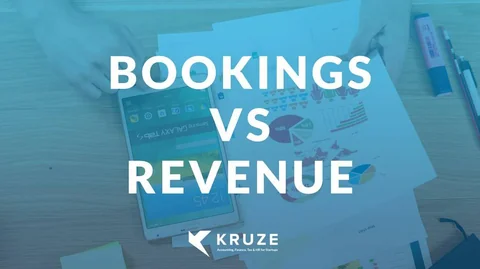
At Kruze Consulting, we get tons of questions about the difference between bookings and revenue. Remember, if you need help with startup accounting, startup tax returns, or startup tax services, partner with Kruze.
In the software as a service world, bookings are the culmination of all the contractual payments you’re gonna get, usually over the next 12 months. So, if you close a $1.2 million contract, over the next 12 months you recognize that as bookings. Despite being a financial number, bookings is not actually defined by GAAP - it’s not technically a number that your accounting firm will produce.
Now, revenue, that is a backward-looking metric and revenue you recognize over the length of the service period. So, if you close that same $1.2 million contract over 12 months, each month going forward you’re gonna recognize $100,000. Revenue is an accounting number. Your accountant will produce it, and if you are doing accrual based accounting - which is the accounting method that VC-backed startups should use- then there are tight rules about how revenue is recorded and recognized.
ARR (Annual Recurring Revenue) is a forward looking metric. ARR is a financial metric used by subscription companies to measure their predictable and recurring revenue generated from subscription-based products or services. It is calculated by multiplying the Monthly Recurring Revenue (MRR) by the number of months in a year. ARR is not a metric recognized by GAAP, and therefore, its calculation may vary among the SaaS and VC communities. One major item to think about when presenting ARR is that many VCs do not consider all revenue to “count” as ARR. For example, some, no recurring items like implementation or overages, are not considered ARR since they are not recurring. This is another non-accounting term, so it’s not something that your accountant will produce. Make sure you discuss how to define it with your investor, as some investors have different ways they like to calculate it (of course, they assume/will tell you that their way is the best and only way to do it).
That’s the difference between bookings and revenue and ARR. The board, the CEO, and the sales team love bookings. That’s a forward-looking metric, and the accountants, like us, love revenue. VCs love ARR, as they run many of their SaaS metrics off of it.
What’s the difference between revenue and ARR?
As we mentioned, revenue refers to the total amount of money generated by a company from its core business activities over a specific period, typically a fiscal quarter or year. It includes income from sales of products or services, as well as any other sources of income such as interest, royalties, or licensing fees. So revenue counts every single dollar a startup makes, no matter where those dollars come from.
Annual Recurring Revenue (ARR), on the other hand, specifically focuses on the recurring portion of a company’s revenue stream. ARR measures the predictable and repeatable revenue that a company expects to receive from subscriptions or contracted services over a 12-month period. This metric excludes one-time sales or non-recurring revenue streams, providing a clearer picture of a company’s long-term revenue-generating capabilities. That’s why it’s so important to VCs – it ignores one-off fluctuations in revenue and shows how much money a startup can be expected to earn annually.
So while revenue encompasses all sources of income within a specified timeframe, ARR specifically isolates and quantifies the predictable and recurring portion of that revenue, providing valuable insights into a company’s financial stability and growth potential.
Generally speaking, the importance of revenue vs. ARR is based on the kind of business you have:
- A SaaS startup is primarily focused on ARR. A solid ARR will continue to grow as long as your startup doesn’t lose subscribers (churn) and continues to add new subscribers. So if your startup sells products or services on a recurring subscription basis, you should track ARR.
- If your business sells products and services without requiring your customers to sign up for an annual or monthly subscription, revenue will be the number you pay the most attention to.
- If your startup sells both one-off products and products requiring a yearly subscription, you need to track both revenue and ARR. And some companies have done this – think about software companies like Adobe, that used to sell its software as a boxed product in stores. Adobe has shifted ot a subscription basis, which evens out their revenue. But for a while it was selling both types of software.
Kruze consulting has quite the client list when it comes to Enterprise SaaS startups. Unlike a lot of our Consumer SaaS clients, Enterprise focused SaaS companies often have an additional layer of complication - bookings, and how these bookings roll into recognized revenue.
What are bookings?
Taking a closer look, let’s talk about what bookings are, and how they compare to the revenue you’d see a public company present.
Bookings for startups represent the commitments made by customers to purchase products or services in the future. While bookings are not an accounting number, they play a crucial role in forecasting revenue and assessing the health of a startup’s sales pipeline. Here’s a breakdown of why bookings are important for startups:
- Bookings are commitments from your customers. Bookings typically refer to the total dollar value of all signed contracts or sales orders received by a company within a specific period. These contracts signify a commitment from customers to purchase products or services, and they often include details such as the quantity, price, and delivery terms.
- Your sales pipeline isn’t bookings. While the sales process begins when a potential customer expresses interest in a product or service offered by the startup, that’s a lead, not a booking. The potential customer indicates interest through various channels such as inquiries, demonstrations, or sales meetings. As the sales process progresses, negotiations take place, leading to the eventual signing of a contract or sales order.
- Signed contracts are important. It’s essential for startups to book revenues only when they have a signed contract or sales order from the customer. This ensures that the commitment is firm and reduces the risk of overestimating revenue. Booking revenues prematurely, before contracts are finalized, can lead to inaccuracies in financial reporting and misrepresentation of the company’s financial health.
- Track your bookings using CRM. While bookings are not recognized as revenue until the products or services are delivered and payment is received, they are still crucial for tracking sales performance and forecasting future revenue. Startups typically record bookings within their Customer Relationship Management (CRM) systems, such as Salesforce or HubSpot. These platforms allow startups to manage customer interactions, track sales opportunities, and store contract details securely.
Bookings help with forecasting. By tracking bookings in their CRM systems, startups can generate accurate sales forecasts and make informed business decisions. Understanding the value and timing of future revenue streams enables startups to allocate resources effectively, plan for growth, and identify potential areas for improvement in their sales processes.
Companies with sales teams or with a setup/delay to the customer go-live date will have “bookings.” A booking is when a prospect agrees to become a client. For most companies, this is when they sign a contract. You may have a salesperson talking to a prospect for a few weeks to many months, but when they finally sign the contract to become a customer you have what is called a “booking.”
For simplicity sake in this post, you can talk about a booking in terms of annual contract value (ACV) or ARR (Annual Recurring Revenue), or Monthly Recurring Revenue (MRR).
ACV is what your new contract will be worth in the 1st year. Note most people exclude any one-time integration or service revenue, although we do have a few clients who like to include that in ACV. We’ve even seen people estimating expected upsells into ACV. Like a lot of SaaS metrics, It’s not a GAAP term, so there is some latitude about how CEOs use it. But it’s important to be consistent; choose a way to calculate it and stick with it.
ARR is the Annual Recurring Revenue from your customers. This the revenue you’d collect in the coming 12 months if you don’t add or churn anything. Some clients want to report out on booked ARR and recognized ARR. We’ll get deeper into that in just a moment.
MRR is the Monthly Recurring Revenue. So it’s the ARR divided by 12. Or you could say ARR is MRR times 12. Again, this can be booked or recognized, depending on how you want to report it.
BUT, now onto the purpose of this piece:
What’s the Difference Between Bookings vs. Revenue in Enterprise SaaS?
As we mentioned above, you can call something a booking when the client signs the contract, even if you aren’t going live with the customer for a while. But you can’t recognize the revenue, according to GAAP, until you are delivering the service to the client.
Here is an example: Let’s say your prospect signs a 12 month, $120,000 contract on January 1st for a service that will begin on February 1st. You can say that your ARR has increased $120,000 - but what you are really saying is that your bookings ARR is up. You won’t (or shouldn’t at least) recognize that revenue until February, at which point your MRR will go up $10,000 ($120,000 divided by 12 months).
Here is a more complicated example, with multiple contracts being signed and going live on different dates:
| 1st contract | 2nd contract | 3rd contract | 4th contract | 5th contract | |
|---|---|---|---|---|---|
| Contract Signed | 1/1/2019 | 2/28/2019 | 2/28/2019 | 3/1/2019 | 3/30/2019 |
| Go Live Date | 2/1/2019 | 3/1/2019 | 4/1/2019 | 3/1/2019 | 4/1/2019 |
| Term | 12 months | 12 months | 12 months | 12 months | 12 months |
| ACV | $120,000 | $120,000 | $120,000 | $120,000 | $120,000 |
One of these contracts will be called a booking and get recognized as revenue in the same month - contract 4. In this contract, the signed date and go live date are both March. The others will be called bookings in the month they are signed, but won’t add to recognized ARR until the month the service starts being delivered.
Here is a breakdown of the above contracts and their booking vs ARR dates:
| January | February | March | April | |
|---|---|---|---|---|
| ACV Bookings | $120,000 | $240,000 | $240,000 | $0 |
| ARR Bookings | $120,000 | $240,000 | $240,000 | $0 |
| MRR Bookings | $10,000 | $20,000 | $20,000 | $0 |
| Recognized ARR | $0 | $120,000 | $360,000 | $600,000 |
| Recognized MRR | $0 | $10,000 | $30,000 | $50,000 |
As the CEO of an Enterprise SaaS company, make sure you understand if you are talking bookings or recognized revenue. Your bookkeeper should be able to help you out if you have questions.
If there is one place we see the automated and “cheapo” bookkeepers mess up, it’s this. Revenue recognition is important - you need to show the right growth curve if you are going to raise the next round of financing. These days, VC term sheets come in fast, which means you need to be ready to quickly present correct historical financials - specifically making sure your MRR and ARR numbers are right.
You can’t tell a potential investor that you have $9 million in ARR over coffee in the morning, and then send historical financials in the afternoon that show you only have $330,000 in monthly recognized revenue. That’s a great way to reduce a VC’s excitement about your company!
NDR and Bookings/ARR growth
Net Dollar Retention (NDR) impacts Net Bookings and ARR in several important ways.
Firstly, NDR is an indicator of the revenue growth or contraction from your existing customer base. If you have high NDR, it means you’re not just retaining customers, but also potentially expanding their accounts (upselling or cross-selling), leading to a boost in ARR and bookings.
On the other hand, if your NDR is less than 100%, it means you’re losing more revenue from churn and contraction (customers downgrading or reducing their spend) than you’re gaining from expansions. This could lead to a decrease in your ARR if not balanced with enough new customer acquisition.
Billings vs Revenue
A common mistake we see founders make is confounding billings with revenue. Billings is when you actually invoice a client (and again, bookings is when the clients signups up for your service). And revenue is recognized when you start delivering the product or service to the client. Some founders (and some of the “automated” bookkeepers) do what is called “cash” based accounting. In cash based accounting the revenue is recognized when it is billed or when the cash is collected - usually, all at once. So if you bill a client up front for a full year’s contract and they pay you, you may be tempted to recognize that all as revenue. That’s a big no-no if you are going to be raising money from VCs; they expect you to be using accrual based accounting.
Video: ARR vs Bookings
Booking ARR is an alternative metric to recognized ARR and is used by some enterprise B2B SaaS companies with longer sales cycles. It measures the value of new annual contracts booked in a given period, regardless of when the revenue is recognized. This can provide a more real-time view of revenue growth and sales performance, especially if the implementation period is long. However, it may not be a reliable indicator of financial performance as it doesn’t account for cancellations or churn, which is where a book to bill ratio can be useful.
Kruze Consulting is a leading CPA firm only serving funded startups. We are experts at SaaS accounting. If you are a funded startup, choose Kruze Consulting’s team of CPAs, bookkeepers, CFOs, former IRS tax auditors, and venture experts. The firm handles all things Accounting, Tax, Finance, & HR: interim CFO Consulting, financial modeling, annual taxes, R&D tax credit studies, venture debt consulting, 409A reporting, bookkeeping, AR/AP, and Seed/Series A/B Fundraising Preparation. Contact Kruze today!












